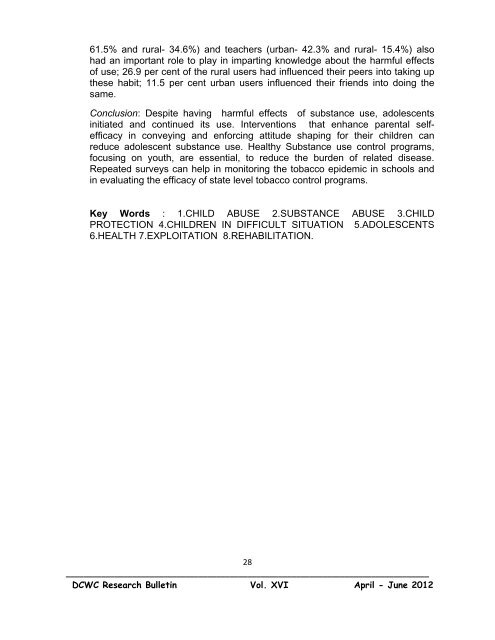Vol. XVI Issue 2 April - June 2012 2012 Documentation ... - Nipccd
Vol. XVI Issue 2 April - June 2012 2012 Documentation ... - Nipccd
Vol. XVI Issue 2 April - June 2012 2012 Documentation ... - Nipccd
You also want an ePaper? Increase the reach of your titles
YUMPU automatically turns print PDFs into web optimized ePapers that Google loves.
61.5% and rural- 34.6%) and teachers (urban- 42.3% and rural- 15.4%) also<br />
had an important role to play in imparting knowledge about the harmful effects<br />
of use; 26.9 per cent of the rural users had influenced their peers into taking up<br />
these habit; 11.5 per cent urban users influenced their friends into doing the<br />
same.<br />
Conclusion: Despite having harmful effects of substance use, adolescents<br />
initiated and continued its use. Interventions that enhance parental self-<br />
efficacy in conveying and enforcing attitude shaping for their children can<br />
reduce adolescent substance use. Healthy Substance use control programs,<br />
focusing on youth, are essential, to reduce the burden of related disease.<br />
Repeated surveys can help in monitoring the tobacco epidemic in schools and<br />
in evaluating the efficacy of state level tobacco control programs.<br />
Key Words : 1.CHILD ABUSE 2.SUBSTANCE ABUSE 3.CHILD<br />
PROTECTION 4.CHILDREN IN DIFFICULT SITUATION 5.ADOLESCENTS<br />
6.HEALTH 7.EXPLOITATION 8.REHABILITATION.<br />
28<br />
__________________________________________________________________________________<br />
DCWC Research Bulletin <strong>Vol</strong>. <strong>XVI</strong> <strong>April</strong> - <strong>June</strong> <strong>2012</strong>

















